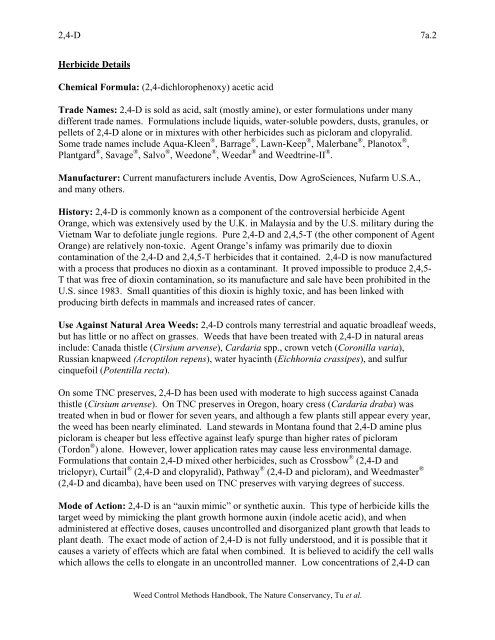Weed Control Methods Handbook: Tools ... - Invasive.org
Weed Control Methods Handbook: Tools ... - Invasive.org
Weed Control Methods Handbook: Tools ... - Invasive.org
Create successful ePaper yourself
Turn your PDF publications into a flip-book with our unique Google optimized e-Paper software.
2,4-D 7a.2<br />
Herbicide Details<br />
Chemical Formula: (2,4-dichlorophenoxy) acetic acid<br />
Trade Names: 2,4-D is sold as acid, salt (mostly amine), or ester formulations under many<br />
different trade names. Formulations include liquids, water-soluble powders, dusts, granules, or<br />
pellets of 2,4-D alone or in mixtures with other herbicides such as picloram and clopyralid.<br />
Some trade names include Aqua-Kleen ® , Barrage ® , Lawn-Keep ® , Malerbane ® , Planotox ® ,<br />
Plantgard ® , Savage ® , Salvo ® , <strong>Weed</strong>one ® , <strong>Weed</strong>ar ® and <strong>Weed</strong>trine-II ® .<br />
Manufacturer: Current manufacturers include Aventis, Dow AgroSciences, Nufarm U.S.A.,<br />
and many others.<br />
History: 2,4-D is commonly known as a component of the controversial herbicide Agent<br />
Orange, which was extensively used by the U.K. in Malaysia and by the U.S. military during the<br />
Vietnam War to defoliate jungle regions. Pure 2,4-D and 2,4,5-T (the other component of Agent<br />
Orange) are relatively non-toxic. Agent Orange’s infamy was primarily due to dioxin<br />
contamination of the 2,4-D and 2,4,5-T herbicides that it contained. 2,4-D is now manufactured<br />
with a process that produces no dioxin as a contaminant. It proved impossible to produce 2,4,5-<br />
T that was free of dioxin contamination, so its manufacture and sale have been prohibited in the<br />
U.S. since 1983. Small quantities of this dioxin is highly toxic, and has been linked with<br />
producing birth defects in mammals and increased rates of cancer.<br />
Use Against Natural Area <strong>Weed</strong>s: 2,4-D controls many terrestrial and aquatic broadleaf weeds,<br />
but has little or no affect on grasses. <strong>Weed</strong>s that have been treated with 2,4-D in natural areas<br />
include: Canada thistle (Cirsium arvense), Cardaria spp., crown vetch (Coronilla varia),<br />
Russian knapweed (Acroptilon repens), water hyacinth (Eichhornia crassipes), and sulfur<br />
cinquefoil (Potentilla recta).<br />
On some TNC preserves, 2,4-D has been used with moderate to high success against Canada<br />
thistle (Cirsium arvense). On TNC preserves in Oregon, hoary cress (Cardaria draba) was<br />
treated when in bud or flower for seven years, and although a few plants still appear every year,<br />
the weed has been nearly eliminated. Land stewards in Montana found that 2,4-D amine plus<br />
picloram is cheaper but less effective against leafy spurge than higher rates of picloram<br />
(Tordon ® ) alone. However, lower application rates may cause less environmental damage.<br />
Formulations that contain 2,4-D mixed other herbicides, such as Crossbow ® (2,4-D and<br />
triclopyr), Curtail ® (2,4-D and clopyralid), Pathway ® (2,4-D and picloram), and <strong>Weed</strong>master ®<br />
(2,4-D and dicamba), have been used on TNC preserves with varying degrees of success.<br />
Mode of Action: 2,4-D is an “auxin mimic” or synthetic auxin. This type of herbicide kills the<br />
target weed by mimicking the plant growth hormone auxin (indole acetic acid), and when<br />
administered at effective doses, causes uncontrolled and dis<strong>org</strong>anized plant growth that leads to<br />
plant death. The exact mode of action of 2,4-D is not fully understood, and it is possible that it<br />
causes a variety of effects which are fatal when combined. It is believed to acidify the cell walls<br />
which allows the cells to elongate in an uncontrolled manner. Low concentrations of 2,4-D can<br />
<strong>Weed</strong> <strong>Control</strong> <strong>Methods</strong> <strong>Handbook</strong>, The Nature Conservancy, Tu et al.
















